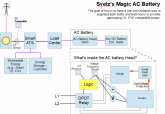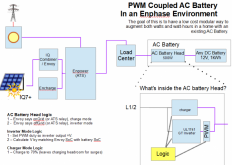There will likely be a little delay in the circuitry for synchronizing the phase. Matching it exactly will probably take something a little clever.
GT inverters do this today and the 120V ones on Amazon don't cost much so at least we know it can be done. I suspect what they do is to use the existing signal on the transistor's
base, so easy to match frequency. Obviously there's a bit of a time lag in the response, but to match phase a small capacitor in front of the base to account for the lag (which should be a fixed delay for the circuitry) should be able to offset whatever the time delay is. I bet you could have phase matching on the first cycle.
...I think a small bank of super caps would do a good job of handling surges to feed it back to the system when things return to normal.
Truthfully, I've no idea how you handle inductor kickback spikes, surges, and from over-production. GT's cap out at a max voltage, so I'm not sure how big of a deal over production is (wind turbines use load-diversion technologies, but that's a different can of worms). Straight-up inductors store energy as a magnetic field which gets dumped when the current stops (Elctroboom has an
amusing video on this) and they can have big spikes. Similarly, spinning motors don't stop immediately because of their momentum. I know you could have a surge protection via clamping (
video) ... but ultimately I don't know what would work best in this situation. Real EEs (e.g.,
@PHoganDive or
@ghostwriter66) could probably tell you. I know it's done in the IQ8 and other inverters so assume it could be done here.
From
@Ampster 's post above it sounds like AC Coupling solutions disconnect the renewable energy until it's battery has discharge enough that can absorb that energy fast enough. That technique wouldn't work with the magic AC battery as it doesn't have any control over the renewable energy source. It's not as bad as it sounds, by definition the renewable energy source has to be able to handle both the surges from the source and from it's own battery. The magic battery only needs to be able to absorb spikes equal to the maximum wattage it can put out, and these will probably be pretty small.
...I think some grid sensing is built into most ATSs.
All the big ones have a relay that flips so it can be used to activate auxiliary systems (e.g., a generator), even if it didn't probably easy to add a relay.
So, might not need the CT...but that's still a transmitter. Ideally it would be nice if you could just plug it in and you're done...having a transmitter/receiver just adds potential problem points. Say for example it could recognize the grid's fingerprint from the energy storage's fingerprint and just magically know or learn which was which. UPSes don't have external sensors, they just work off low voltage, so that technique might be a possibility.
...The system will need more CTs than that. One would be needed on the load and one on the GT inverter AC output. Until recently the Tesla Powerwall used a Nuerio which transmitted over 485 protocol to the brain module contained in the transfer switch or the Powerwall.
I agree the main brain needs them.
But I don't believe the magic AC battery needs more. The
main energy controller in the diagram is handling the renewable energy production, the magic AC battery just matches voltage when the conditions are met -- keep in mind this isn't a
current source like a GT inverter, it's a
voltage source... so no current would flow
unless the voltage lags.[/QUOTE]






